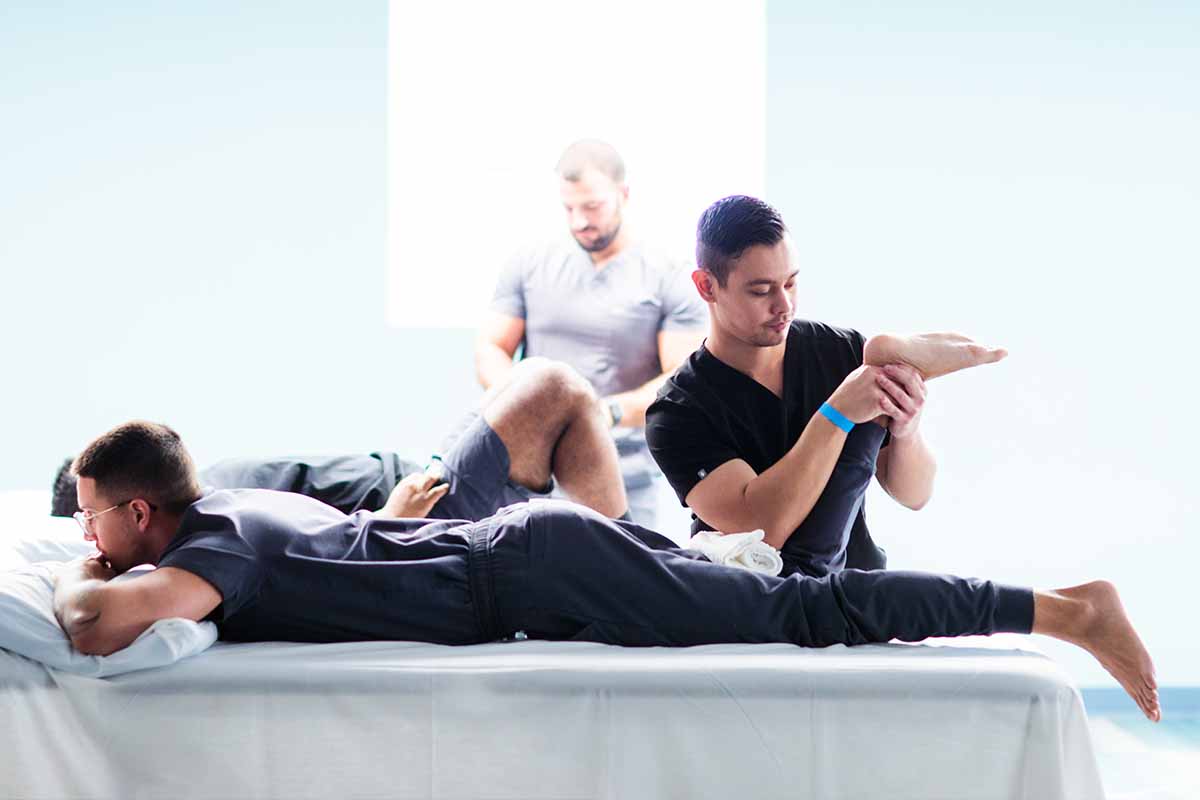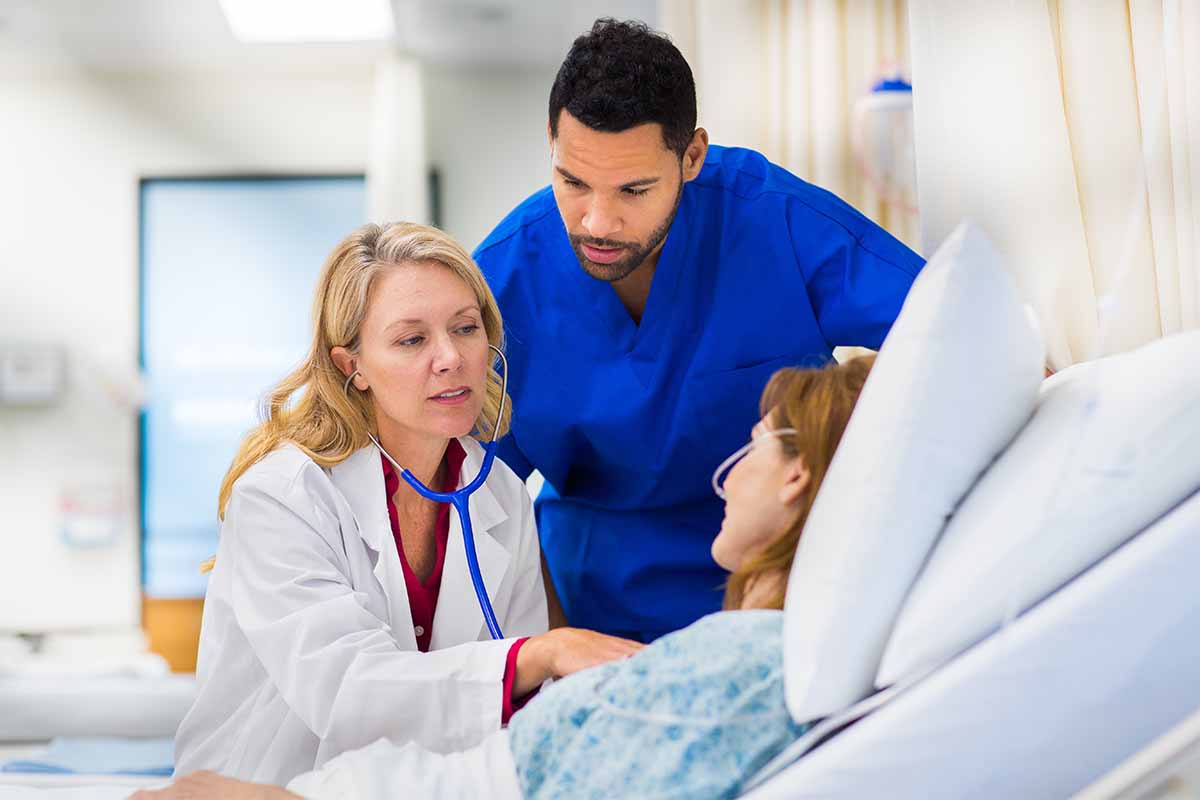
Nurse practitioners (NPs) and medical doctors (MDs) spend their days making a difference in people’s lives. Providers in both professions treat patient illnesses and injuries with the best science and acute care techniques. In the U.S. healthcare system (depending on the state), both can serve as primary care providers.
The main difference between a nurse practitioner and doctor is that NPs undergo less training than MDs—so their responsibilities differ. Review the main differences between the education and job description of an NP vs. MD to help you decide which career could be right for you.
What is a Nurse Practitioner?
A nurse practitioner is a licensed clinician who is focused on providing evidence-based, empathic care to patients. Not only does this type of advanced practice nurse treat acute and chronic conditions—they also focus on preventive and holistic care.
What Do Nurse Practitioners Do?
The typical responsibilities of nurse practitioners may include1:
- Recording patient medical histories and performing physical exams
- Administering primary and emergency care to patients
- Creating patient treatment plans, prescribing medications and monitoring progress
- Ordering and administering diagnostic tests
- Educating patients about the benefits of healthy nutrition and exercise for disease prevention
- Providing mental health support
Is a Nurse Practitioner a Doctor?
No, nurse practitioners aren’t doctors. However, there are some states where nurse practitioners have full practice authority – in these cases, they are able to act as primary care providers. In fact, according to the American Association of Nurse Practitioners (AANP), 88 percent of NPs are certified in an area of primary care, while 70.3 percent of all NPs actually deliver primary care.2
Key Differences: Nurse Practitioner vs. Doctor


The Difference in Responsibilities Between an NP vs. MD
Nurse practitioners and medical doctors share many of the same responsibilities. In 27 states, two U.S. territories and Washington D.C., NPs have full practice authority, which means they can evaluate patients, order and interpret diagnostic tests, create and manage treatment plans and prescribe medications—all without physician oversight.3
The difference between an NP and MD is distinct in the remaining states, where nurse practitioners have reduced or restricted practice. This means they must have a medical doctor sign off on specific patient care decisions.3
The Educational Difference Between a Nurse Practitioner and Doctor
Whether you’re thinking about becoming a nurse practitioner vs. doctor, you must undergo rigorous schooling. However, both career paths are rewarding, and whether you decide to pursue an NP vs. MD education, you will be working to improve the lives of others.
One advantage of becoming a nurse practitioner vs. doctor is that students are more easily able to keep working while pursuing a nurse practitioner education. With online graduate nursing programs like those at the University of St. Augustine for Health Sciences (USAHS), it’s possible to hold down a job while getting your doctoral degree or master’s degree, as online learning programs offer flexibility.
To become a nurse practitioner, complete the following requirements:
- Earn a Bachelor of Science in Nursing (BSN): Your path to a BSN may vary depending on your prior education, but a full-time BSN program typically takes four years to complete. USAHS offers BSN graduates the ability to enter directly into our MSN or DNP programs and advance their career opportunities. It typically takes students 2-3 years* to complete their BSN to MSN and 2.3-4 years* to complete their BSN to DNP .
- Pass the NCLEX-RN examination: Pass the NCLEX to earn your nursing license, required for practice as a registered nurse (RN). After licensure, it’s recommended that you gain two or more years of work experience before applying to graduate school; however, requirements vary by program.
- Earn a graduate degree: Earn a Master of Science in Nursing (MSN) or Doctor of Nursing Practice (DNP) with a nurse practitioner role specialty, such as Family Nurse Practitioner (FNP), Psychiatric Mental Health Nurse Practitioner (PMHNP), Adult Gerontology Nurse Practitioner (AGNP)** and more. After your didactic coursework, complete a clinical practicum and work directly with a preceptor, in a clinical setting, for several hundred clock hours. If you earned your RN license, hold an ADN degree and have one year of full-time experience as an RN, but don’t hold a BSN degree, you may enroll directly in an MSN program at USAHS. Choose an RN to MSN program to earn your MSN in 3.3-3.7 years* as you progress to the next level.
- Become a Certified Nurse Practitioner (CNP): Take a national certification exam through one of the five national certification boards to become licensed as a nurse practitioner.
Learn More About USAHS Graduate Nursing Programs
Another difference between an NP and MD is that doctors spend more time in school than nurse practitioners: They attend a four-year medical program and then complete an accredited residency training program. Depending on the area of specialty, the residency takes at least three years.4 The steps to become a medical doctor typically include:5
- Earn a bachelor’s degree: Your bachelor’s degree can be in any subject ,but medical schools require several prerequisite courses.
- Take the Medical College Admission Test® (MCAT®): Before applying to medical school, complete this standardized test.
- Earn a Doctor of Medicine (MD): In this typically four-year program, medical students complete coursework and clinical experience that prepare them for their internship and residency.
- Pass the U.S. Medical Licensing Examination (USMLE): When considering paths as an NP vs. MD, consider exam requirements. Before applying for a medical license and practicing in the U.S., you must pass this three-step test.6
- Complete residency training: Resident physicians typically spend three to seven years training alongside health practitioners under the supervision of attending physicians. The first year of residency is called the internship.
- Obtain a state license: To practice, physicians must become licensed in their state. Regulations vary from state to state.
- Earn a board certification (optional): Physicians can become board-certified in their chosen specialty.
Specialization Differences of a Nurse Practitioner vs. Doctor


What can a doctor do that a nurse practitioner cannot, and vice versa? Nurse practitioners and doctors can specialize or sub-specialize in a particular area. Nurse role specialties tend to be different from those for MDs. For example, a nurse practitioner may specialize in women’s reproductive health and childbirth as a women’s health nurse practitioner (WHNP) or family nurse practitioner (FNP)7. A physician would specialize in obstetrics and gynecology as an OB-GYN.
Common Nurse Practitioner Role Specialties
- Family Nurse Practitioner (FNP)
- Pediatric nurse practitioner
- Orthopedic nurse practitioner
- Adult Gerontology Nurse Practitioner (AGNP)**
- Psychiatric Mental Health Nurse Practitioner (PMHNP)
- Clinical Nurse Specialist (CNS)
- Nurse anesthetist
Common Physician Specialties
- Family medicine
- Pediatrics
- Physical medicine and rehabilitation
- Psychiatry
- Internal medicine
- Surgery
The Difference Between an NP and MD in the Work Environment
Physicians typically work in private offices, group practices, clinics and hospitals.8 Doctors also work in academia, for the government and various other settings.
Nearly half of nurse practitioners work in the offices of physicians.9 About one-fourth work in state, local and private hospitals. NPs also work in outpatient care centers, educational services and the offices of other healthcare practitioners.
NP vs. MD: How Do Career Outlooks Differ?
U.S. News & World Report ranks the profession of nurse practitioner as #1 in its 2024 Best Health Care Jobs list.10
The demand for nurse practitioners is growing at a rapid rate. Employment is projected to grow 40 percent between 2023 and 2033, with an estimated 31,900 jobs being added each year during that period.11 In 2023, the median base salary for full-time NPs was $129,480.11 This is significantly higher than the median base salary for RNs, which was $86,070 in 2023.12
At 4 percent, the estimated growth rate of physician employment is much lower than that for nurse practitioners, with an estimated 23,600 jobs added each year between 2023 and 2033.13 Regarding nurse practitioner vs. doctor salary, MDs earn more. The U.S. Bureau of Labor Statistics (BLS) states that in 2023, the median annual wage for physicians and surgeons was equal to or greater than $239,200.13
The Need for Nurse Practitioners
In 2024, the Association of American Medical Colleges (AAMC) updated their projections, predicting that the United States will see a shortage of up to 86,000 physicians by 2036.14 Since the U.S. population is growing and aging, the demand for physicians is growing faster than the supply.14
It’s possible that nurse practitioners, who can deliver primary care without physician supervision in more than half of U.S. states, will help close this gap. Inflexible care models that rely on physicians to deliver primary care are contributing to the fact that a growing number of patients lack access to primary care.15
It has long been the vision of nurse practitioners to close this gap. In 1965, assistant professor of nursing Loretta Ford and pediatrician Henry Silver developed the pediatric nurse practitioner (PNP) role at the University of Colorado, suggesting that this role could “bridge the gap between health care needs of children and families’ ability to access and afford primary health care.”16
Choosing between a career as an NP vs. MD largely depends on your personal and professional goals, as both roles are highly rewarding positions in healthcare.
The University of St. Augustine for Health Sciences (USAHS) offers Master of Science in Nursing (MSN), Doctor of Nursing Practice (DNP), and Post-Graduate Nursing Certificates designed for working nurses. Our degrees are offered online, with optional on-campus immersions***. Role specialties include Family Nurse Practitioner (FNP), Psychiatric Mental Health Nurse Practitioner (PMHNP), Adult Gerontology Nurse Practitioner (AGNP),** Nurse Educator,*** ** and Nurse Executive. The MSN has several options to accelerate your time to degree completion. Complete coursework when and where you want—and earn your advanced nursing practice degree while keeping your work and life in balance.
*Time to completion may vary by student, depending on individual progress, traditional vs. accelerated pathway, credits transferred and other factors.
**Call for availability
***The FNP role specialty includes a required hands-on clinical intensive as part of the curriculum.
****The Nurse Educator role specialty is not available for the DNP program.
Sources:
- Maura Deering, “Nurse Practitioner vs. Doctor (Physician),” NurseJournal, August 1, 2024, https://www.nursepractitionerschools.com/faq/np-vs..-doctor/.
- American Association of Nurse Practitioners, “NP Fact Sheet,” AANP, February 2024, https://www.aanp.org/about/all-about-nps/np-fact-sheet.
- American Association of Nurse Practitioners, “Issues at a Glance: Full Practice Authority,” AANP, November, 2023, https://www.aanp.org/advocacy/advocacy-resource/policy-briefs/issues-full-practice-brie.
- John S. Andrews, MD and AMA Resident & Fellow Section (RFS) Governing Council, “What is residency?” AMA, https://www.ama-assn.org/medical-students/preparing-residency/what-residency.
- Association of American Medical Colleges, “The Road to Becoming a Doctor,” November 2020: https://www.aamc.org/system/files/2019-12/Road_to_Becoming_a_Doctor_December%202019.pdf.
- Princeton Review, “What Is the USMLE?,” Princeton Review, 2024, https://www.princetonreview.com/med-school-advice/usmle.
- Nursing License Map, “How to Become a Nurse Practitioner,” Nursing License Map, October 2021, https://nursinglicensemap.com/advanced-practice-nursing/nurse-practitioner/.
- U.S. Bureau of Labor Statistics, “Physicians and Surgeons: Summary,” BLS, April 17, 2024, https://www.bls.gov/OOH/healthcare/physicians-and-surgeons.htm.
- U.S. Bureau of Labor Statistics, “Nurse Anesthetists, Nurse Midwives, and Nurse Practitioners: Work Environment,” BLS, April 17, 2024: https://www.bls.gov/OOH/healthcare/nurse-anesthetists-nurse-midwives-and-nurse-practitioners.htm#tab-3.
- U.S. News & World Report, “Best Health Care Jobs,” U.S. News & World Report. 2024, https://money.usnews.com/careers/best-jobs/rankings/best-healthcare-jobs.
- U.S. Bureau of Labor Statistics, “Nurse Anesthetists, Nurse Midwives, and Nurse Practitioners: Summary,” BLS, April 17, 2024, https://www.bls.gov/OOH/healthcare/nurse-anesthetists-nurse-midwives-and-nurse-practitioners.htm#tab-1.
- U.S. Bureau of Labor Statistics, “Registered Nurses: Summary,” BLS, April 17, 2024, https://www.bls.gov/OOH/healthcare/nurse-anesthetists-nurse-midwives-and-nurse-practitioners.htm#tab-1.
- U.S. Bureau of Labor Statistics, “Physicians and Surgeons: Summary,” BLS, April 17, 2024, https://www.bls.gov/OOH/healthcare/physicians-and-surgeons.htm.
- American Association of Medical Colleges, “New AAMC Report Shows Continuing Projected Physician Shortage,” AAMC, March 21, 2024: https://www.aamc.org/news/press-releases/new-aamc-report-shows-continuing-projected-physician-shortage.
- Christopher Kerns and Dave Willis, “The Problem with U.S. Health Care Isn’t a Shortage of Doctors,” Harvard Business Review, March 16, 2020: https://hbr.org/2020/03/the-problem-with-u-s-health-care-isnt-a-shortage-of-doctors.
- Arlene W. Keeling, “Historical Perspectives on an Expanded Role for Nursing,” The Online Journal of Issues in Nursing, May 31, 2015, http://ojin.nursingworld.org/MainMenuCategories/ANAMarketplace/ANAPeriodicals/OJIN/TableofContents/Vol-20-2015/No2-May-2015/Historical-Perspectives-Expanded-Role-Nursing.html.








